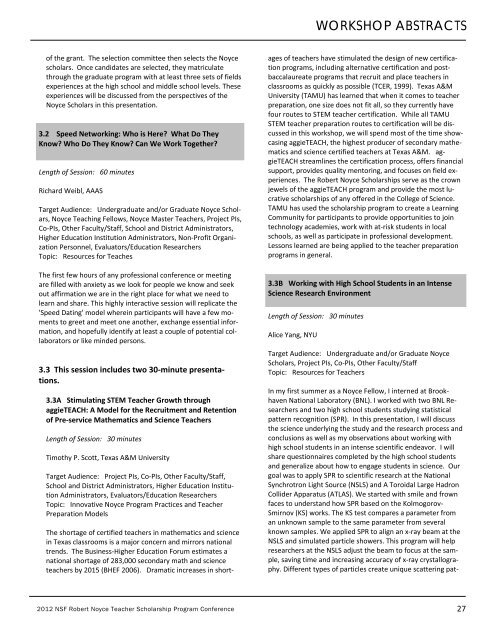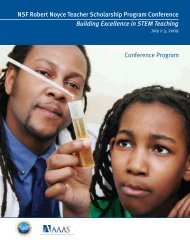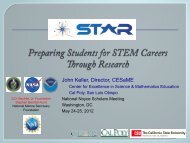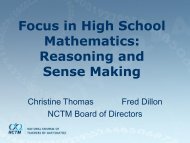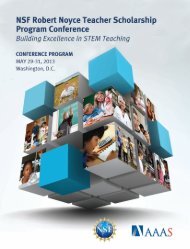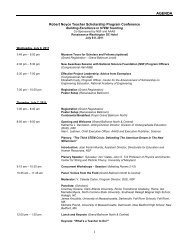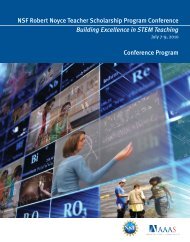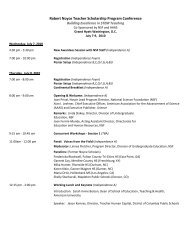WORKSHOP ABSTRACTS2.14 Understanding Teacher Research: Perspectives onStudent Learning and Adaption of Curricular MaterialsDuring a Middle School Unit on Climate ChangeLength of Session: 60 minutesMelissa George, National Science FoundationTarget Audience: Undergraduate and/or Graduate <strong>Noyce</strong> Scholars,<strong>Noyce</strong> Teaching Fellows, <strong>Noyce</strong> Master TeachersTopic: Resources for TeachersIn this workshop, participants will explore some of the “bestpractices” of STEM education teachers who strive to becomereflective practitioners in their classrooms. Participants will gainan understanding of how teachers achieve coherent learninggoals for their students by continually assessing what studentsknow about various climate change topics, adapting curriculumto build on this knowledge, and reflecting on the outcomes ofthese adaptations. <strong>The</strong> findings and the issues highlighted in thisworkshop are likely to foster discussion and encourage futureteachers to explore the complexity of tailoring teaching to meetstudent needs.or his own mentor teacher for a mixture of observing andteaching.For the additional SCE, however, each methods class as awhole links up with one local master teacher. <strong>The</strong> teachercandidates and professor together observe two lessons, andhave the opportunity to debrief with the teacher. Studentshave particularly expressed their appreciation of the opportunityto “get in the master teacher’s mind,” as one student putit. <strong>The</strong> students then collaborate to design and deliver a lessonin the same master teacher’s classroom. This lesson is alsodebriefed with the master teacher.In addition to their direct benefits, the SCE serve as a text thatinfluences later university classroom discourse. With traditionalindividual field experiences, students encounter differentschools, teachers, and curricula, and it can be difficult inthe university classroom to have productive, whole‐class conversationsregarding such idiosyncratic experiences. <strong>The</strong> SCEprovide a common set of experiences to which students andprofessors can refer when discussing course content. <strong>The</strong> SCEwere first piloted in the Methods of Teaching SecondaryMathematics in Fall 2010 and were expanded to three additionalmethods courses in 2011.Session III: Friday, May 25, <strong>2012</strong>9:10am - 10:25am3.1B Do Field Experiences Really Matter: Perspectives of<strong>Noyce</strong> Scholars3.1 This session includes two 30‐minute presentations.3.1A Shared Classroom Experiences in Teacher PreparationLength of Session: 30 minutesJeffrey Carpenter, Elon UniversityTarget Audience: Project PIs, Co‐PIs, Other Faculty/Staff,School and District Administrators, Higher Education InstitutionAdministrators, Evaluators/Education ResearchersTopic: Innovative <strong>Noyce</strong> <strong>Program</strong> Practices and TeacherPreparation ModelsElon University's Secondary and K‐12 Teacher Education programshave recently added shared field experiences (SCE) toour teacher preparation. In the semester before full studentteaching, our fourth year students take a teaching methodscourse in their content areas (e.g., Methods of Teaching SecondaryMathematics). <strong>The</strong>se courses include a traditional, 50‐hour field placement in which each student is placed with herLength of Session: 30 minutesAndre M. Green, University of South AlabamaKelly Byrd, kbyrd@usouthal.edu, University of South AlabamaTami May, Ashley Velazquez, Peter Kupfer, and L. MichaelVesoulis, <strong>Noyce</strong> ScholarsTarget Audience: Undergraduate and/or Graduate <strong>Noyce</strong>Scholars, <strong>Noyce</strong> Teaching Fellows, Project PIs, Co‐PIs, OtherFaculty/Staff, School and District AdministratorsTopic: Innovative <strong>Noyce</strong> <strong>Program</strong> Practices and TeacherPreparation Models<strong>The</strong> <strong>Noyce</strong> Pathway to Science and Mathematics programs atthe University of South Alabama requires all candidates interestedin becoming <strong>Noyce</strong> scholars to complete a ten‐week (2days per week) internship. <strong>The</strong> program pairs the interestedcandidates with a mentor teacher identified by the partnerschool district as being a great teacher in a high need school.Students are required to complete a set of activities designedby the mentor teachers during the internship experience. Atthe conclusion of the experience, candidates interview beforea selection committee of school principals, the science andmath supervisor of the district, and the principal investigators26<strong>2012</strong> NSF <strong>Robert</strong> <strong>Noyce</strong> Teacher <strong>Scholarship</strong> <strong>Program</strong> <strong>Conference</strong>
WORKSHOP ABSTRACTSof the grant. <strong>The</strong> selection committee then selects the <strong>Noyce</strong>scholars. Once candidates are selected, they matriculatethrough the graduate program with at least three sets of fieldsexperiences at the high school and middle school levels. <strong>The</strong>seexperiences will be discussed from the perspectives of the<strong>Noyce</strong> Scholars in this presentation.3.2 Speed Networking: Who is Here? What Do <strong>The</strong>yKnow? Who Do <strong>The</strong>y Know? Can We Work Together?Length of Session: 60 minutesRichard Weibl, AAASTarget Audience: Undergraduate and/or Graduate <strong>Noyce</strong> Scholars,<strong>Noyce</strong> Teaching Fellows, <strong>Noyce</strong> Master Teachers, Project PIs,Co‐PIs, Other Faculty/Staff, School and District Administrators,Higher Education Institution Administrators, Non‐Profit OrganizationPersonnel, Evaluators/Education ResearchersTopic: Resources for Teaches<strong>The</strong> first few hours of any professional conference or meetingare filled with anxiety as we look for people we know and seekout affirmation we are in the right place for what we need tolearn and share. This highly interactive session will replicate the'Speed Dating' model wherein participants will have a few momentsto greet and meet one another, exchange essential information,and hopefully identify at least a couple of potential collaboratorsor like minded persons.3.3 This session includes two 30‐minute presentations.3.3A Stimulating STEM Teacher Growth throughaggieTEACH: A Model for the Recruitment and Retentionof Pre‐service Mathematics and Science TeachersLength of Session: 30 minutesTimothy P. Scott, Texas A&M UniversityTarget Audience: Project PIs, Co‐PIs, Other Faculty/Staff,School and District Administrators, Higher Education InstitutionAdministrators, Evaluators/Education ResearchersTopic: Innovative <strong>Noyce</strong> <strong>Program</strong> Practices and TeacherPreparation Models<strong>The</strong> shortage of certified teachers in mathematics and sciencein Texas classrooms is a major concern and mirrors nationaltrends. <strong>The</strong> Business‐Higher Education Forum estimates anational shortage of 283,000 secondary math and scienceteachers by 2015 (BHEF 2006). Dramatic increases in shortagesof teachers have stimulated the design of new certificationprograms, including alternative certification and postbaccalaureateprograms that recruit and place teachers inclassrooms as quickly as possible (TCER, 1999). Texas A&MUniversity (TAMU) has learned that when it comes to teacherpreparation, one size does not fit all, so they currently havefour routes to STEM teacher certification. While all TAMUSTEM teacher preparation routes to certification will be discussedin this workshop, we will spend most of the time showcasingaggieTEACH, the highest producer of secondary mathematicsand science certified teachers at Texas A&M. aggieTEACHstreamlines the certification process, offers financialsupport, provides quality mentoring, and focuses on field experiences.<strong>The</strong> <strong>Robert</strong> <strong>Noyce</strong> <strong>Scholarship</strong>s serve as the crownjewels of the aggieTEACH program and provide the most lucrativescholarships of any offered in the College of Science.TAMU has used the scholarship program to create a LearningCommunity for participants to provide opportunities to jointechnology academies, work with at‐risk students in localschools, as well as participate in professional development.Lessons learned are being applied to the teacher preparationprograms in general.3.3B Working with High School Students in an IntenseScience Research EnvironmentLength of Session: 30 minutesAlice Yang, NYUTarget Audience: Undergraduate and/or Graduate <strong>Noyce</strong>Scholars, Project PIs, Co‐PIs, Other Faculty/StaffTopic: Resources for TeachersIn my first summer as a <strong>Noyce</strong> Fellow, I interned at BrookhavenNational Laboratory (BNL). I worked with two BNL Researchersand two high school students studying statisticalpattern recognition (SPR). In this presentation, I will discussthe science underlying the study and the research process andconclusions as well as my observations about working withhigh school students in an intense scientific endeavor. I willshare questionnaires completed by the high school studentsand generalize about how to engage students in science. Ourgoal was to apply SPR to scientific research at the NationalSynchrotron Light Source (NSLS) and A Toroidal Large HadronCollider Apparatus (ATLAS). We started with smile and frownfaces to understand how SPR based on the Kolmogorov‐Smirnov (KS) works. <strong>The</strong> KS test compares a parameter froman unknown sample to the same parameter from severalknown samples. We applied SPR to align an x‐ray beam at theNSLS and simulated particle showers. This program will helpresearchers at the NSLS adjust the beam to focus at the sample,saving time and increasing accuracy of x‐ray crystallography.Different types of particles create unique scattering pat‐<strong>2012</strong> NSF <strong>Robert</strong> <strong>Noyce</strong> Teacher <strong>Scholarship</strong> <strong>Program</strong> <strong>Conference</strong>27
- Page 1 and 2: NSF Robert Noyce Teacher Scholarshi
- Page 3 and 4: NSF Robert Noyce Teacher Scholarshi
- Page 5 and 6: CONTENTSAbout the NSF Robert Noyce
- Page 7 and 8: AGENDAWEDNESDAY, MAY 23, 20123:30 p
- Page 9 and 10: HOTEL FLOOR PLANS2012 NSF Robert No
- Page 11 and 12: SPEAKER BIOGRAPHIESL’Oreal USA an
- Page 14 and 15: WORKSHOP ABSTRACTSSession I: Thursd
- Page 16 and 17: WORKSHOP ABSTRACTSTarget Audience:
- Page 18 and 19: WORKSHOP ABSTRACTS1.8 Preparing Noy
- Page 20 and 21: WORKSHOP ABSTRACTStutorials for usi
- Page 22 and 23: WORKSHOP ABSTRACTSentation, three o
- Page 24 and 25: WORKSHOP ABSTRACTS2.9 Science NetLi
- Page 31 and 32: WORKSHOP ABSTRACTSThis session will
- Page 33: WORKSHOP ABSTRACTSColleges for Teac
- Page 36 and 37: WORKSHOP ABSTRACTSlesson and will p
- Page 38 and 39: PI POSTER ABSTRACTS1Title: Teachers
- Page 40 and 41: PI POSTER ABSTRACTSJulie A. Luft, A
- Page 42 and 43: PI POSTER ABSTRACTSClinical experie
- Page 44 and 45: PI POSTER ABSTRACTSon topics includ
- Page 46 and 47: PI POSTER ABSTRACTSof the group at
- Page 48 and 49: PI POSTER ABSTRACTSopportunities. E
- Page 50 and 51: PI POSTER ABSTRACTS3. Partnership w
- Page 52 and 53: PI POSTER ABSTRACTSpated in four ty
- Page 54 and 55: PI POSTER ABSTRACTS41Title: Teacher
- Page 56 and 57: PI POSTER ABSTRACTSpost‐baccalaur
- Page 58 and 59: PI POSTER ABSTRACTSThe internships
- Page 60 and 61: PI POSTER ABSTRACTSin the degree pr
- Page 62 and 63: PI POSTER ABSTRACTSPresenter(s): Ro
- Page 64 and 65: PI POSTER ABSTRACTSSanthi Prabahar,
- Page 66 and 67: PI POSTER ABSTRACTSNicholle Stark,
- Page 68 and 69: PI POSTER ABSTRACTSprograms and dis
- Page 70 and 71: PI POSTER ABSTRACTSresulting in tea
- Page 72 and 73: PI POSTER ABSTRACTSyears. We have m
- Page 74 and 75: PI POSTER ABSTRACTSschool district,
- Page 76 and 77:
PI POSTER ABSTRACTS95Title: The Noy
- Page 78 and 79:
PI POSTER ABSTRACTS101Title: SUNY C
- Page 80 and 81:
PI POSTER ABSTRACTSresources and su
- Page 82 and 83:
PI POSTER ABSTRACTSThis project als
- Page 84 and 85:
PI POSTER ABSTRACTSThe UCR Noyce Sc
- Page 86 and 87:
PI POSTER ABSTRACTSInstitution: Uni
- Page 88 and 89:
PI POSTER ABSTRACTSedge through the
- Page 90 and 91:
PI POSTER ABSTRACTSand program cont
- Page 92 and 93:
PI POSTER ABSTRACTS136Title: Title:
- Page 94 and 95:
PI POSTER ABSTRACTSIn addition, the
- Page 96 and 97:
PI POSTER ABSTRACTSgoals for next y
- Page 98 and 99:
PI POSTER ABSTRACTS152Title: Univer
- Page 100 and 101:
PI POSTER ABSTRACTSCo‐PI(s): Susa
- Page 102 and 103:
PI POSTER ABSTRACTSwork samples fro
- Page 104 and 105:
PI POSTER ABSTRACTSPresenter(s): Mi
- Page 106 and 107:
PI POSTER ABSTRACTSThe action resea
- Page 108 and 109:
PI POSTER ABSTRACTSin‐service tea
- Page 110 and 111:
SCHOLAR/FELLOW POSTER ABSTRACTSward
- Page 112 and 113:
SCHOLAR/FELLOW POSTER ABSTRACTSers
- Page 114 and 115:
SCHOLAR/FELLOW POSTER ABSTRACTSS/F1
- Page 116 and 117:
SCHOLAR/FELLOW POSTER ABSTRACTScert
- Page 118 and 119:
SCHOLAR/FELLOW POSTER ABSTRACTSThis
- Page 120 and 121:
SCHOLAR/FELLOW POSTER ABSTRACTSS/F4
- Page 122 and 123:
SCHOLAR/FELLOW POSTER ABSTRACTSS/F5
- Page 124 and 125:
SCHOLAR/FELLOW POSTER ABSTRACTSthe
- Page 127 and 128:
POSTER ABSTRACT INDEXAAbraham, Larr
- Page 129 and 130:
POSTER ABSTRACT INDEXEscalante, Mic
- Page 131 and 132:
POSTER ABSTRACT INDEXLandon, Laurie
- Page 133 and 134:
POSTER ABSTRACT INDEXRodriguez, Jen
- Page 135:
POSTER ABSTRACT INDEXZZaikowski, Lo


